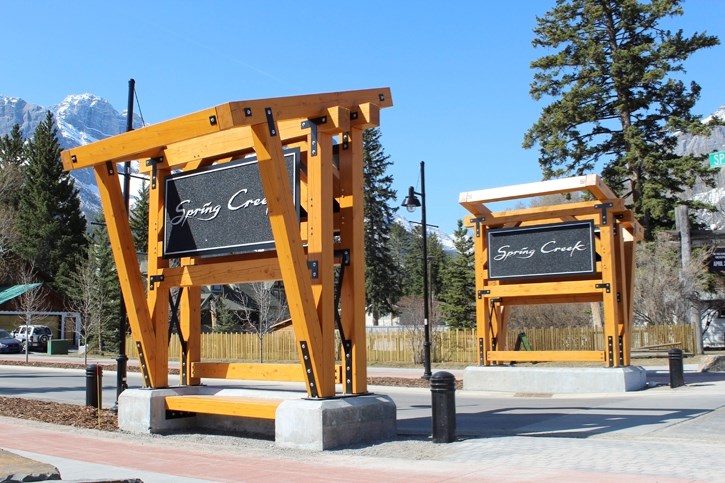Canmore's development appeal board has thrown out an appeal for two new Spring Creek Mountain Village signs on Main Street.
The signs were installed at the entrance to the subdivision of Spring Creek Mountain Village earlier this year, but because there was no development permit process and they were concerns expressed in the community about their height, it became a contentious issue for the municipality.
As a result, administration initiated a development permit process after the fact, which went in front of Canmore's Planning Commission and was denied.
But it was a different tune at the Subdivision and Development Appeal Board, as chair Ron Casey questioned whether the quasi-judicial board had the jurisdiction to even hear the appeal in front of them.
Casey noted the permit at issue was for a monument sign, but the Land Use Bylaw and prior council policy has different standards for entrance features and wayfinding signage on public land that are more appropriate in this situation.
"This was jointly designed and planned by the Town of Canmore and it is on Town of Canmore property – it is no different than any other wayfinding sign," Casey said. "If there are any questions around its appropriateness, that is really something for council and administration to address. But as the development appeal board, we deal with signs designed as part of the development process and these signs were not designed as part of a development process.
"I am really questioning if we have an appeal here tonight actually."
Planner Nathan Grivell briefed the board on how the appeal ended up before them. He said administration was unaware of the 2001 protocol for entrance features in a road right of way. The protocol sets out that a development permit is not required because the process involves design negotiations between the applicant and the development authority.
"Unfortunately, due to a lack of recent entrance signage applications and turnover in staff, we were unaware until recently that this existed," Grivell said. "As a result of public reaction, planning staff made the decision to apply for a development permit and applied signage regulations that were more restrictive than the circumstances called for."
Grivell said the signage was first identified as needed for the subdivision, which is expected to have 2,000 residents at build out, in the 2004 approved area redevelopment plan.
The concept initially had the sign in the middle of the roadway, however, and given that Canmore has adopted a complete street design and the intersection of Main Street and Spring Creek Drive was the very first project to use that design, the location and number of signs changed as a result said developer Frank Kermick.
Kernick said he worked with the municipality's engineering department on the road's re-design, as well as a comprehensive landscaping plan – both processes included creating wayfinding signage for SCMV. He said the process was the same as the one he went through for the roundabout on Bow Valley Trail and entrance signage to the subdivision from that location.
"This was no different than the process we did with the roundabout," Kernick said after the appeal was dismissed. "Our intention when we did the road design process with the Town's engineering department was that it was a public process."
The road design for the intersection was put out for feedback in the community and the artist rendering included the two signage features. The height, Grivell said, and the fact there are two signs on either side of the road are to create sight lines, visibility and clearance for large vehicles. He said administration supports the current design of the signage as appropriate given its location and context.
"In this case, engineering thought the signage was wayfinding in that it points to the community or signals that Spring Creek is this way and as a functional sign they permitted it," he said.




